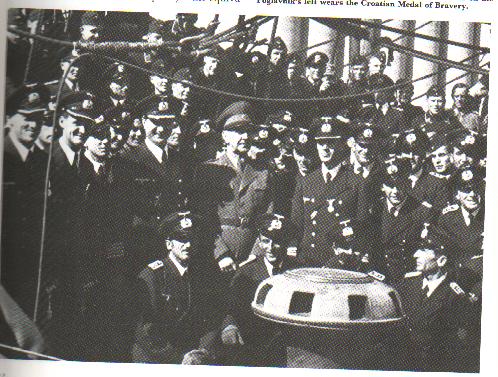Ukrainians in Kriegsmarines and other Axis Navies
As the Second Warld War broke out, many Ukrainians also appeared in the German navy. Although the number of volunteers was not as high as in the Werhmach, national units were formed by the Navy. Ukrainian and other foreign volunteers either formed small units and were of the same status as the kriegsmarines or joined the german units of Armed Forces Assistance Personel (Wehrmachtgefolge).
Ukrainians joined the German navy in two ways
1. The former members of Ukrainian Navy of 1918 who had settled in Galicia and those Galicians who served in Polish Navy, had volunteered and served in the Baltic and Atlantic.
2. Ukrainian prisoners of war from the Soivet Navy, who were taken to Kriegsmarines and served primary but not necessary in the Black Sea. In adition they also formed a costal defence battery in Northern France.
The national shields and cocades were introduced in 1944. Uniforms and rank insignia were the same as the blue or field-gray navy uniform of German marines. Axiliaries would wear uniforms without the national patches but instead would use a yellow "Deutsche Wehrmacht" armband. Theoretically for all European volunteers the ranks were listed all the way up to the rank of the admiral, even such rank would never be bestoved. For auxiliaries, they could be promoted to Obergefreiter and by exemption to Aaat if their employment as an auxiliary in a duty position of Maat would replace a German NCO for the front-line duties.
The interpretors wore a black band, which bore a white inscription "Shprachmitter" (Interpreter) in Latin letters.
On July 19th, 1944 Order No.83 required German soldiers to salute indigenous officers in the same manner as German officers, and required a "mutual comradely salute" between German and indigenous soldiers.
Ukrainian Kriegsmarine
(Updated picture)
On August 11th, Order No.109 prohibited the further use of terms "foreign" (auslandische) or "germanic" (Germanische) volunteers, and substituted the term "European" (Europaische) volunteers in the navy publications.
When the national patches for Galician volunteers were a similar patch to SS youth in Galicia - a blue with yellow rampart lion. Volunteers from the rest of Ukraine, according to order No.508 used a similar patch as Ukrainian Liberation Army - blue and yellow shield with a white Trident of St. Volodymyr.
Cocades for the volunteers were as follows: A golden lion on blue oval shield for the Galicians and a blue and yellow cocade for Ukrainian volunteers, for officers, with a separated outer yellow oval.
Ukrainians in Croatian Naval Legion
Many Ukrainians also served in Chroatian Naval Legion. The Croatian Naval Legion (Hrvatska Pomorska Legija) was formed on June 2nd 1941 by order of Poglavnik Ante Pavelich, who needed volunteers to fight on the Eastern Front. The Legion was comanded by captain Stepan Rumenovich and originally composed of 23 officers, 100 pety officers and 220 sailors. The Legion was equipped with ships and captured fishing wessels wich were converted for minesweeping operations.
The Legion mainly functioned in the Black Sea, off the coast of Ukraine and came into contact with the local population. Due to correct behavior on behalf of the legion, the local population supported the legion during its stay in Ukraine. Because of this support the

Poglavnik Ante Pavelic with members of the Naval Legion at the Black Sea
Legions commander wanted to recruit as many Ukrainian volunteers as possible. Many former sailors and fishermen had volunteered and the legion's size had increased to 1000 men, now with Ukrainians composing 60% of the whole Legion.
The Legion ahd continuosly engaged with overwhelming Soviet forces and proven to be victorious. Thanks to the sailors of the Legion, the commader of the 11th German Army, Eric von Manhstein was rescured as his boat was afire after an areal attack. Ukrainians in the Legion fought hard and many became distinguished for their deed. Commader Edgar Andzheli stated that "Ukrainian volunteers in the struggle for the Azov Sea had showed a great courage and exellency, which was greatly asknowledged".
Towards the end of 1942 the Legion handed over its ships to other sailors and returned to Croatia to regroup. In October 1943 the Legion was transfered to Triest where its members were distributed among the ships of the German navy.